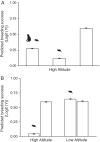Spatial heterogeneity of mesopredator release within an oceanic island system
- PMID: 18083843
- PMCID: PMC2409232
- DOI: 10.1073/pnas.0707414105
Spatial heterogeneity of mesopredator release within an oceanic island system
Abstract
Predator-prey communities are ubiquitous in ecology, but introduced predators can drive native species to extinction within island systems, prompting the eradication of such exotics. Ecological theory predicts that elimination of top-introduced predators from islands can lead to the counterintuitive decline of native prey populations through the ecological release of smaller introduced species in a process termed "mesopredator release." We show, in accordance with mesopredator release theory and counter to conservation goals for a New Zealand island reserve, that initial eradication of cats on Little Barrier Island led to reduced breeding success of Cook's petrels, which also are vulnerable to predation by a mesopredator, the Pacific rat. The rat's impact on prey productivity varied with elevation within the island. Rat eradication was followed by a rise in petrel productivity, in support of both ecological theory and practical conservation management goals. It appears that interactions among introduced predators, native prey, and environmental gradients can drive counterintuitive and spatially heterogeneous responses to predator eradications from islands. Location-specific, ecosystem-level understanding is essential for predicting the outcomes of such restoration management techniques.
Conflict of interest statement
The authors declare no conflict of interest.
Figures


Comment in
-
Using aliens to explore how our planet works.Proc Natl Acad Sci U S A. 2008 Jan 8;105(1):9-10. doi: 10.1073/pnas.0711228105. Epub 2008 Jan 2. Proc Natl Acad Sci U S A. 2008. PMID: 18172193 Free PMC article. No abstract available.
References
-
- Estes JA, Tinker MT, Williams TM, Doak DF. Science. 1998;282:473–476. - PubMed
-
- Pace ML, Cole JJ, Carpenter SR, Kitchell JF. Trends Ecol Evol. 1999;14:483–488. - PubMed
-
- Gehrt SD, Clark WR. Wildl Soc Bull. 2003;31:836–842.
-
- Terborgh J. BioScience. 1974;24:715–722.
-
- Soule ME, Bolger DT, Alberts AC, Wrights J, Sorice M, Hill S. Conserv Biol. 1988;2:75–92.
Publication types
MeSH terms
LinkOut - more resources
Full Text Sources
Other Literature Sources
Miscellaneous

